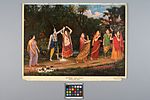Dan Leela
About this object
History of use
Indian popular religious prints have been published for nearly a century, first by German presses, later by Indian ones. The prints may take the form of calendars, posters, or simply images. The style of the representations is European. In the beginning they were Hindu images, but are now acquiring elements both of folk art and a romantic secularism. It is a living art currently influenced by the movie industry and non-Hindu religions. The images are a vehicle for advertising and are also used for religious purposes. This one printed in Germany for South Indian market, then framed and displayed in a prayer room for 'puja' or worship.
Narrative
From collection of calendar prints collected in Southern India.
Cultural context
popular religious art
Iconographic meaning
Krishna, eighth incarnation of Vishnu is associated with strength, vigor, and life. He is unmindful of the cares of everyday living, and subdues any evil with laughter. Can be shown as the divine child (mischievous, impulsive, spontaneous) or as the divine lover with the milkmaids. His favorite, Radha, shows her adoration for him as symbol of a worshipper's passionate devotion. He calls people to lose themselves in bliss by the sound from his flute. Also identified by: blue grey or light blue skin, peacock feather in tiara, u-shaped Vaishnavite third eye, peacock and bovine, full moon, and landscape settings reminiscent of Gopal Krishna living among the cowherds.
Physical description
Rectangular print depicting Krishna with six black-haired females standing on dirt road in front of lush, dark green, treed landscape, temple and houses partially hidden in upper right. Four females on right in green, red, orange and gold saris and head veils. Each carry black jug on shoulder, one with jug on head. All four look back at male and female in red sari, as he reaches up with arm on right to pour white liquid from black jug female carries on head. Blue and green peacock in full display behind. Male carries stick-like object in hand on left. He wears peacock feather in jeweled tiara on head, yellow dhoti and a blue waist sash. He is adorned with floral garland around neck as well as pearl (?) necklaces, bracelets, and armbands. Remaining female looks on from left, smashed jugs and white liquid on ground in front of her.
Categories
Materials
